AUTHOR’S NOTE (4/11/2023): I wrote this blog post over a decade ago. Since then, I’ve started illustrating a story about a little mouse who is searching for her own cheese. You can read the first chapter for FREE right here.
Trader Joe’s has a large selection of cheeses, and their cheese is very affordable, compared to other supermarkets and specialty food stores. My friend, Lydia, had a conversation with blogger Ann Marie (aka: Cheeseslave) on facebook discussing the cheese selection at Trader Joes. The conversation was so educational, I had to share it with you all. Today when I was at Trader Joe’s, I took pictures of the cheeses that they discussed. Below is an edited version of their back-and-forth:
LYDIA asks CHEESESLAVE: At Trader Joe’s I have the choice between raw milk cheese from cows not treated with rBST or cheese from grass-fed/pastured milk that has been pasteurized (Kerry Gold and New Zealand cheddar). Which is better?
CHEESESLAVE : With no other information, I would go for the Kerrygold. You can ask TJ’s where there cheeses (and other products) come from — they always happily divulge the info to me when I ask. Ask them where the raw milk cheese comes from — which farm. I think it’s good to pester them about this stuff so they will be better about labeling.
The New Zealand cheddar is good too. Grass-fed pasteurized cheese is better than raw milk cheese that is not necessarily from cows eating grass. They need the grass to produce the vitamin K2!
LYDIA: That’s good to know. They do carry a few great European cheeses that are raw (Morbier, Comte, an Abbaye cheese, a cave-aged Tomme, and the Italian grating cheeses) and I assume those are probably grass-fed because Europe hasn’t caught up with the industrial farming. But the raw-milk cheddar is from New York. I’ll ask them about it – but it’s definitely pretty white in color.
CHEESESLAVE : I don’t think it’s safe to assume that the cheeses from Europe are all grass-fed.
LYDIA: I was inspired to do some research! Here it goes:
Parmigiano Reggiano (which TJ’s sells at a comparatively reasonable price) may only be made from grass and forage-fed milk.
Grana Padano cows may be fed silage though-bummer, I guess the cheap price reflects the quality.
Pecorino Romano may only be made from milk of sheep who have grazed a particular combination of grasses and nothing else.
Comte “cows may only be fed fresh, natural feed, with no silage” according to Wikipedia. I’m not sure what that means exactly, but it could certainly include grain.
Morbier is only made in Jura mountain villages, so I think it’s safe to assume that it’s at least partially grass-fed.
Abbaye St. Mere is made at Trappist monasteries-so I make a similar assumption. I have a hard time picturing monks shoveling silage into feed pens, but maybe I’m wrong!
I would suggest though that Europe does not have access to all the cheap corn, which our industrial farmers use with abundance as cattle feed, and there is a much greater sense of the importance tradition there. Certain cheeses and meats have to be made the way they always have been – right down the animals’ diets. *end conversation*
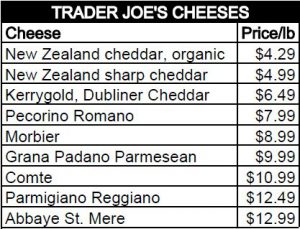 Thank you Lydia and Cheeseslave for your insights into this microcosm of the wild and wonderful work of cheese. I created a chart to summarize the cheese choices discussed in this blog post. I hope to find more resources to guide buying decisions. Do you have a resource that explains or delves into the quality of cheeses? Do you know of a local creamery that does things well? Please, share your experiences!
Thank you Lydia and Cheeseslave for your insights into this microcosm of the wild and wonderful work of cheese. I created a chart to summarize the cheese choices discussed in this blog post. I hope to find more resources to guide buying decisions. Do you have a resource that explains or delves into the quality of cheeses? Do you know of a local creamery that does things well? Please, share your experiences!
By ekwetzel
2010-11-19

A Story For Cheese Lovers
Do you like cheese? Then you’ll LOVE my children’s story:
Calico Jill and the Search For Cheese!

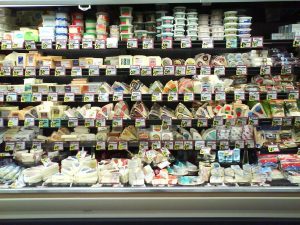
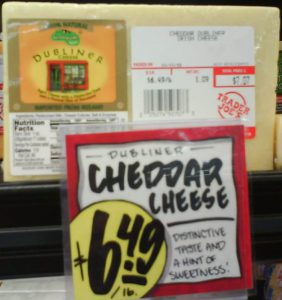

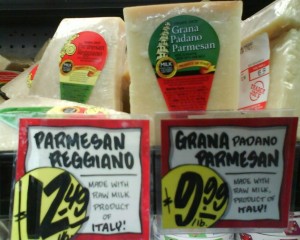

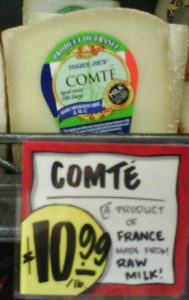
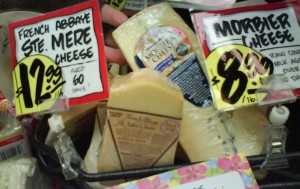
I lead the Nourishing Our Children campaign, we are a project of the Weston A. Price Foundation. and wanted to share some of our presentation content from a slide titled, “Cows on Pasture” … “Real feed for cows is green grass in Spring, Summer and Fall; green feed, silage [sie-lage], hay and root vegetables in Winter.”
Grass fed cows will get silage in winter. It’s okay!
I got the best tasting raw, grass fed, full fat cheese at Costco two wks ago. They no longer carry it. Where can I buy it? La Montagne, Compte is the name on package. Four of us loved it!!
Costco has a tendency to only carry certain products during certain seasons. They carry more varieties of cheeses during winter months, and then carry fewer when warmer months roll around. If you have a Trader Joe’s nearby, I’d check them out to see if they have a comparable cheese (TJ prices are pretty reasonable). Otherwise, I’d ask your local Costco when they plan on carrying the “La Montagne Compte” cheese again. (This wiki article might help you find a comparable cheese: http://en.wikipedia.org/wiki/Comt%C3%A9_cheese )
Sandrine ;o) Thanks for the comment. It’s educational.
That is helpful! We have Kerrygold cheese at Costco, it’s double the price of other cheese, but it’s worth it for the superior product. If we ever get a TJ’s out here in Montana, I’ll know what to shop for 🙂
Cara – I just took photos of the cheeses at Costco this week. I’m going to start doing research, and I hope to have a similar post in the near future geared towards shopping for cheese at Costco.
Interesting, but I would like to know if the raw milk has still been heated, which apparently destroys it nutritionally. I only drink raw milk and get it from Organic Pastures, a California dairy.
Here is a link to their page on raw milk cheese:
http://www.organicpastures.com/products_cheese.html
That’s a good question. I don’t have an answer, but I’d be interested in knowing, as well.
Hi. I stumbled across this blog while researching Morbier, a cheese I just bought at Trader Joe’s. I’m under the impression, having eaten and traveled there, that the European cheese makers almost all use grass fed cows and/or sheep. First of all, they aren’t nearly as able as Americans to get cheap corn. Also, they are very traditional, and loathe to change anything about their methods. A very unAmerican trait, but it works for them nutritionally.
I have a recent anecdote to endorse the use of raw milk and aged European cheeses from grass fed cows, raw or not. Yesterday, I received results from two urine ntx tests. The back story is that I have osteoporosis, and I had been taking Fosomax for at least 15 years. My doctor took me off of it, since there have been some horrible instances of spontaneous femur breaks in patients taking bisphosphonates for extended periods. I was really nervous about this, since my baseline bone density I took prior to stopping Fosomax showed I was osteopenic. Scary to stop a drug that has helped this in the past.
When I went off the drug in July, I started seeking out raw milk, and I think I started drinking it instead of Trader Joe’s regular, no BST milk, about two months ago. I was buying Organic Pastures, which I buy at our Santa Barbara Farmer’s Market.
Side note:
Sadly, two weeks ago, Organic Pastures had instances of ecoli in San Diego, so FDA shut all of the company down. I’m waiting anxiously for them to solve this problem and come back on the market. Alta Dena used to have raw milk but gave up years ago, because the milk industry with the FDA’s cooperation, made them shut down repeatedly, and they probably worried about the lawyers going after them, too.
Okay, back to the anecdote.
So, I’ve been consistently eating European aged cheeses (for the K2), and drinking raw milk, for the myriad of benefits, for about two months.
When I stopped the biphosphonate drug, my doctor ordered Urine ntx tests every six weeks to monitor my bone resorption. The range of results is very broad, from 20-53, with the lower the better being the rule. It tells you how much bone you are retaining.
In July, my rate was 33. Not bad. Now keep in mind that Fosomax stays in the body for months, if not years.
However, in October, my rate was down to 14. This is really good news. It means I am not losing bone, and the rate of resorption is actually better than when I was taking the drug. The difference is my consumption of grass fed cow/sheep dairy. My doctor was really pleased and surprised. She said that the rate, 14, is something she sees in patients who are actively taking biphosphonates. Her husband has a virtual farm in their backyard, and she had been considering buying a goat or miniature cow for the milk, and now she’s convinced.
Keep in mind, this is anecdotal. I hope the next urine ntx shows results as good as this one, but I will be continuing this diet.
In addition to K2 from the grass fed component, raw milk has many other benefits, taste being a big one. My children, who are in their 40’s now, had stopped drinking milk when they were 10 and 12 years old. I began buying Alta Dena, raw in the 80’s, and they loved it and drank it as though they couldn’t get enough. They must have needed it, and not just for the calcium. They didn’t like the pasteurized, homogenized milk. I was saddened when it was no longer available. Raw milk has been shown in studies to prevent breast cancer, and I’m sure there are many other ailments it helps avoid.
There are important things about organic milk that I found out, too. Organic Horizons is mostly from corn fed cows, and only Organic Valley and Whole Foods 365 organic brands have been vetted to be from grass fed cows. So if one can’t get raw milk, these are the two currently grass fed milks.
So that’s my pitch, and I’m even more convinced about this since my test results.
Thanks for a great blog. Keep it up.